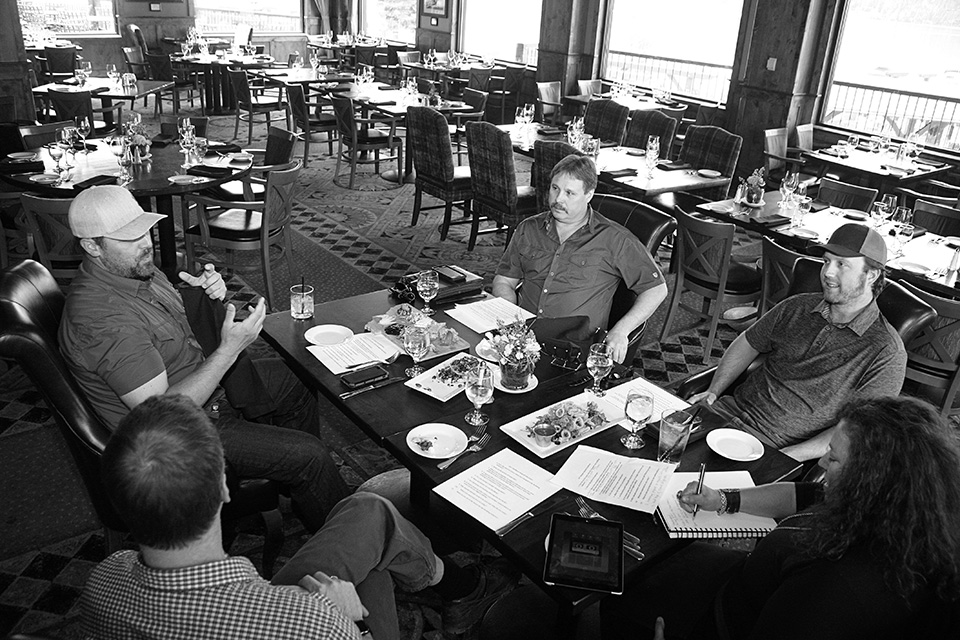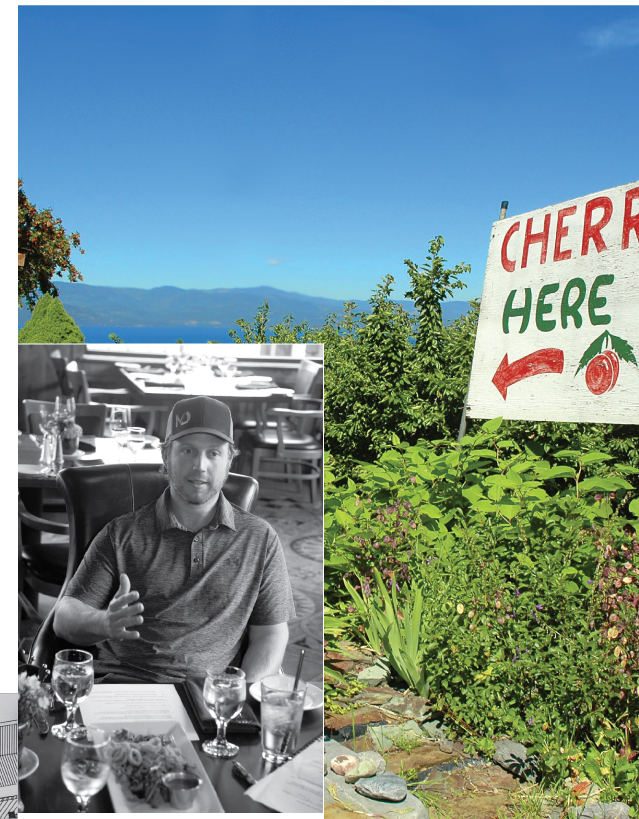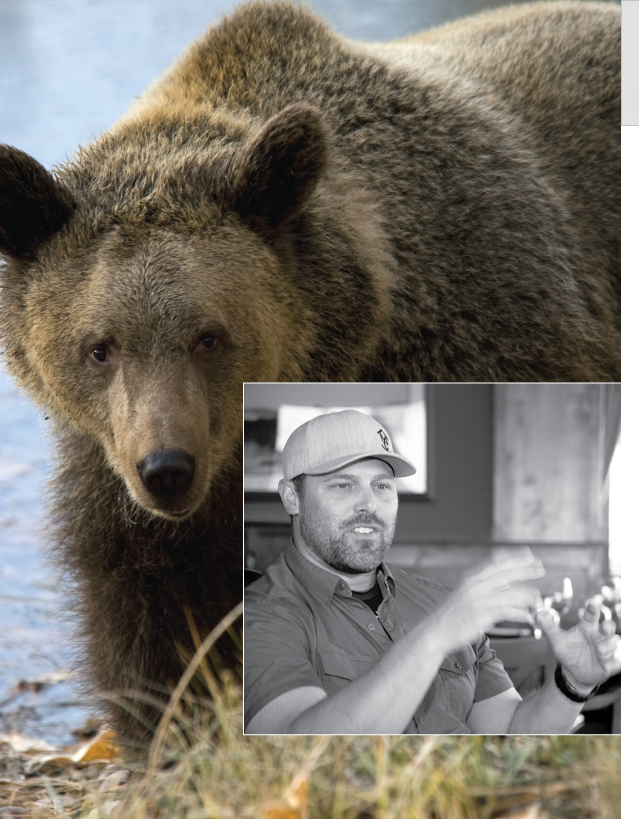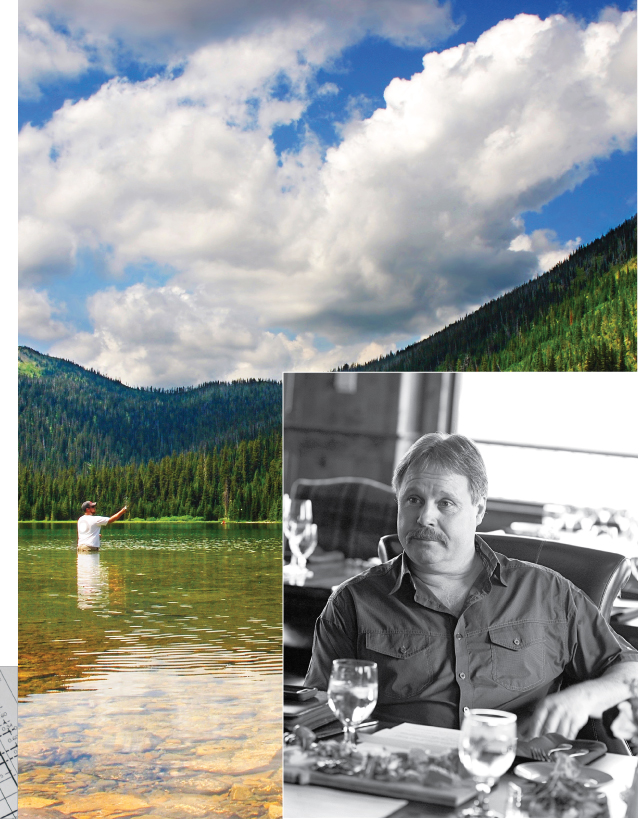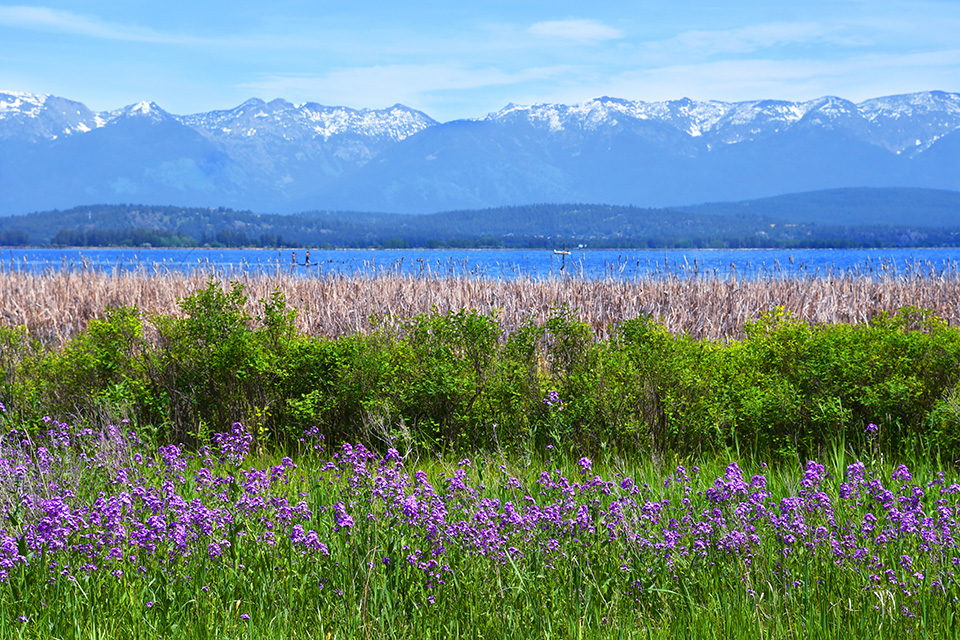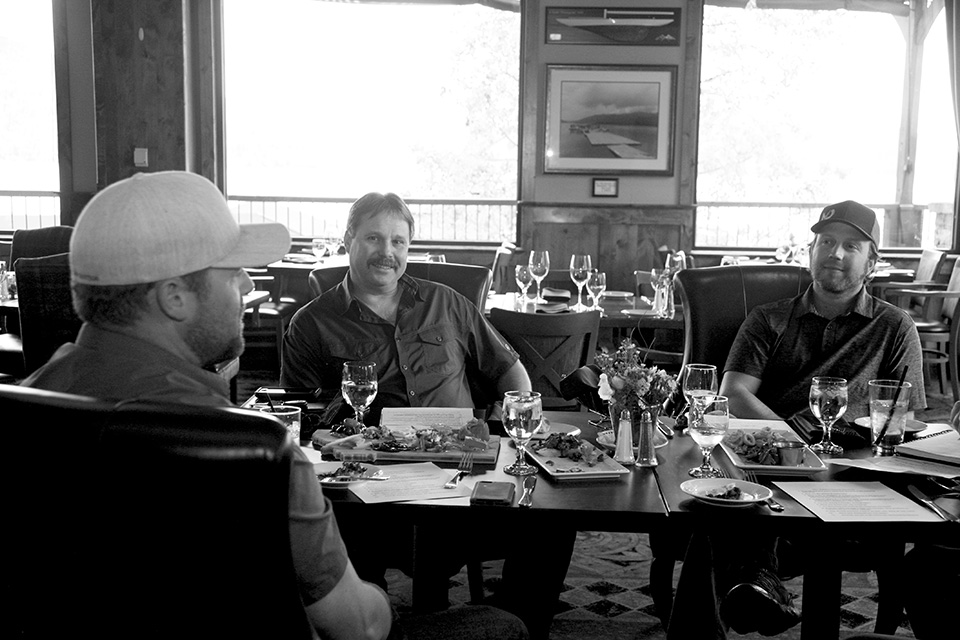Thoughts on the Current Market
The happenings in the world of builders in this northern reach of Montana may surprise you. Construction is flourishing and contemporary building ideas are on the rise. New trends, important issues, and the future of Flathead Valley home building are all topics that Tyler Frank of Malmquist Construction, Jason Pohlman of Mindful Designs, and Brad Reedstrom of Bigfork Builders discuss at Western Home Journal’s most recent builder roundtable. Assessing products, the industry, tariffs, and finding what you need to know about building in the Flathead Valley involves many levels of understanding, which these top tier builders have.
What is the future of the building industry if young people are not attracted to the trades and the idea of becoming master craftsmen? The building industry is seeing this change. Houses have shrunk by twenty percent in size in the last three years, yet small details have grown more complicated. What does this mean to your pocketbook? Quality is ruling over quantity.
Why are clean lines so difficult? Ten years ago, homes had generic standards. Now, details are incredibly intricate throughout the entire process of home construction, and there’s no room for error. Read on and find out more about this growing building market and how the Flathead Valley’s top builders continue to evolve.
“I think the feeling of a connection to timeless mountain living will always have a draw in our area.”
– Jason Pohlman | Mindful Designs
whj: Over the last five years, what has changed in the building industry?
Jason: On the client side, I think due to the Internet, they’re more informed about what they want, specifically the web-based organization tools for ideas and information available on home design details.
Brad: I agree. Client’s expectations in the last few years regarding products have been very advanced.
whj: What do you mean by advanced?
Brad: They’re more knowledgeable about the process and the products. They’re looking for a higher degree of products, materials, and finishes.
whj: Is this because clients have more access to information?
Brad: I think it starts with them as they are dreaming and planning their homes. They’re seeing and have easy access to examples of homes and products. The first thing on their mind is that they want to build the best house possible. It used to be that when they walked in the door, they were talking about basic items. Now, it’s right off the bat about windows, details, and finishes as well as ‘can you get me this and that product,’ and ‘I want to build the best house I can.’ When they walk through the door, they’re already so far ahead from what used to be. They’ve almost built the entire house in their head before they start to talk to you.
Tyler: Ten years ago, if you had a heartbeat, you were hired. Then, there was a point in 2010 when the fly-by-night guys were filtered out. Five years ago, quality contractors and subcontractors were staying alive because of the quality of work they did, and from that point on, there was a reset period with a focus on quality not quantity. Today, I’m seeing how everyone is super busy but not really trying to take on more projects, but they’re being selective on the quality of projects. Instead of ten projects, they’re doing five.
whj: Is that changing the look of what’s happening in the region? Can you notice the difference?
Tyler: I think that’s about the size of a home. Ten years ago, we were building 10,000-square-foot homes. Now, it’s gone down to 6,000-square-foot homes but the quality of construction is better. People are doing less but with higher quality and better finishes. They want the reputation of spending time on the details.
whj: Is there more competition now?
Brad: This valley has always been somewhat competitive. However, I don’t think it’s any more competitive that it was. Certainly, there’s much more work than five years ago, when it was only the guys who did a really good job, had a good reputation, and were the only ones who had work. Consistently, we compete against the same guys as we did five or even ten years ago. Everyone keeps raising the level of the quality of work they do.
Jason: The last five years may not have been so much about the style but certainly about the quality. The aesthetic has changed.
Brad: You can see it in the classic rustic home that was so popular ten years ago. It was the norm. There are still many people who come here from populated areas who have the dream of this rustic log cabin in Montana. They have that fancy bling in Miami, but that’s not what they want here.
“The things that move inside your home are always good places to put your money because you will get better quality from those components—these things include door hinges, door and window hardware, windows, and plumbing fixtures.”
– Tyler Frank | Malmquist Construction
whj: How are the prices of materials?
Jason: For the Canadian timber, there will be an increase because of the tariff.
Brad: It will affect us some, because we all tap into that market. Other than timber, it seems like most of the materials are just following inflation with a steady increase. We’re past the days of big spikes in concrete and steel. Those shortages have, in a sense, tapered off. You will always get a product that will spike in price because some kind of event happened.
Tyler: I think on those commodity-type items we use in the building industry, there will always be price increases. We’re also seeing products that were new to the market three years ago that are more mainstream today. For example: a tile that was $12 per foot and is now $6 per foot. I think we see those different product lines at a low from what we were paying years ago. LED lights for instance, have come down in price.
Brad: We have so many more options now for suppliers and materials. There are more types of tile and LED lights, which helps with the pricing.
whj: What is the availability of skilled craftsmen in the area now? Will there be a sufficient number in the future? Will some skills be in more demand than others?
Tyler: For the caliber of builders like us, we have our own niche of men who are on our team. When you get into some of these production builders who have to do more volume, there’s a need to have six or seven different framing crews as opposed to what we have: three or four we shift around on a project. I don’t see an issue on a shortage of labor. There are bottleneck periods within our own projects like when six projects start at one time and you need six concrete guys, but I know I’m always going to have a concrete guy who is going to show up. I think it’s a different struggle with the type of product line that you are dealing with—quality versus quantity.
Jason: The majority of craftsmen are not on the young side. Young people are not taking to the trades, and it takes time to develop the skill set needed for the caliber of the homes we’re building today. We’d like to see more dedicated young craftsmen on the site learning hands.
Brad: It’s definitely true that younger people are not taking to the trades in the numbers that they used to. It’s too bad. Now is one of the best times ever to be in this industry, there’s good pay and benefits and projects are out there.
whj: What do you all do to attract young people to the industry?
Brad: The educational system is geared toward putting young people through college. We’ve been involved for years with the local Student Built House Program. There’s a little bit of exposure, but it takes a lot to make things happen. It takes a big partnership with the industry and the people in it because the high schools don’t foster that relationship independently.
Tyler: Construction and trade work wasn’t in the school system so we had to create this Flathead Valley Student Built Home program. It dissolved in 2010 when the economy turned. As the economy strengthens, we knew we had to get it back because we were going to see a shortage of work in skilled trades. Flathead High School is doing a two-period full house build course. The first year they had 30 students and the second year they had 90. It has big support from the Flathead Valley Builders Association and other builders.
Brad: It’s an important issue. The industry we are in is hands-on. Although there’s more automation for creating products nowadays, in the end, these beautiful homes will always be handcrafted. It’s going to take skilled labor—not just pulling someone off the street to teach how to build homes in one day.
Jason: Trade skills can be trendy. Our concrete guy was flying his drone and taking photos on the foundation he created. It was great because he was showing off his work, and he feels proud of his work.
“People want to live in a piece of art.”
– Brad Reedstrom | Bigfork Builders
whj: It appears there is a continual shift toward contemporary and modern; how does that change construction practices from those needed for building in a mountain rustic style?
Brad: I don’t see the rustic totally going away, but there’s certainly a lot less of it.
Jason: We’re working on a 550-square-foot cabin remodel and maintaining that feel of a Forest Service cabin. I think the feeling of a connection to timeless mountain living will always have a draw in our area.
Tyler: It’s a fun challenge to have to help the design team and the owner to develop something that’s never been developed before. Creating a look with some of the mixtures of rustic and contemporary components of houses is what I enjoy. I like being involved with some of the final design and constructability. It gives you a hint of the client’s vision and you expand off of that. With some of the new product lines, such as fireplaces, it is about more than what you do with the rock that surrounds it. You’re implementing steel and exposed iron as well as stone. They’re not just functional. They’re decorative. There’s a lot of texture being applied.
Brad: Tyler is spot-on about being involved with the architect. It’s one of the things that’s different. The architect and the builder are working together and, in most cases, as a team, as the house is being designed. The architect is using the builder as a resource in determining how the home will be built. There’s not a black and white template. Builders are part of the design process from the beginning.
Jason: Sequencing has to change in some cases. With some of the clean finishes such as no trim on a door, a door has to be hung before the sheet rock is on or at the same time. This is a trend we’re seeing.
Brad: After the design is done, the construction is so far advanced that elements have to be coordinated together. In the past, you would never think about your window rough openings as you’re digging a hole in the ground. It’s either perfect or spot -on, or it does not work.
whj: Are you seeing a younger demographic?
Tyler: I am. There are younger families moving to the area for a variety of reasons. The lifestyle is a major draw, and it has become easier to work from a remote location.
Brad: It ranges. A typical client is 35 to 50 years old. I’ve seen a lot of families moving here–coming from populated areas, and they want to move here with their children to raise them in this environment.
Jason: The ability to work remotely has become more acceptable in the workplace.
Brad: Technology has allowed for people to live here in the Flathead Valley, and be part of a board meeting in Chicago at the same time.
Tyler: I also think the retirement age has come down a great deal. Many of my clients are retiring in their mid-50s, not 70s. I think they’re getting more financially stable at a younger age.
whj: What attracts people to this area?
Jason: People are here to be in a beautiful setting, and they have active lifestyles year-round.
Brad: It’s definitely a lifestyle and the overall feeling of this area. It’s a comfortable setting, and it’s laid-back. It’s not Aspen or ultra crazy.
Jason: It’s always fun to see the closet design for some of these people. There are no tie racks.
whj: What size homes are you building?
Brad: The average for us is between 4,000 and 6,000-square feet. It’s not about the size of the house, it’s all about the level of quality of what’s in the house.
“It starts with them as they are dreaming and planning their homes. The first thing on their mind is that they want to build the best house possible.”
–Brad Reedstrom | Bigfork Builders
whj: Any new requests or trends?
Tyler: Since we’re not a 12-month golf season, I’ve done some golf simulators in a few of the homes here.
Brad: There are many homes with indoor shooting ranges and concrete vaults for gun collections.
Tyler: I think people are focusing on the outdoor living more and more. It’s not just strictly outdoors either.
Jason: Outdoor heaters and automated shades can extend the times of use for these outdoor living spaces longer into the colder temperatures in spring and fall.
Tyler: They want big windows with operable bi-folding doors that open the inside to the outside.
Jason: That’s been an industry change in the last five years with more of the larger openings appropriate for the climate. It’s been a big change, and we’re seeing more door manufacturers achieving doors that will work for these openings in our climate.
Brad: The way the indoors and outdoors are connected has changed, and it has made the outdoor spaces spectacular. You can have a smaller house and make it live so much larger.
whj: Are financing and lending affecting how you build?
Tyler: Interest rates are low, and you would think people would take advantage of this by earning more on their money elsewhere. My clients are using cash.
Brad: The only clients who are using construction lending are those who want some additional level of oversight and having a lender involved ensures that the draw, progress, and procedures are all correct. They will not take out a loan if they don’t need it. We have some really good banks in our valley that have some great construction lending programs. Clients don’t have to use out-of-town banks, they can use local.
Tyler: American Bank and Glacier Bank are a couple of our local banks. They both have some really great construction lending programs.
whj: If clients come up with a little extra budget, what products or features do you suggest adding?
Brad: Outdoor living space is where clients are focusing on extra spending.
Tyler: Sometimes the house is designed around the outdoor living because of a rock outcropping that exists or a 150-year-old pine tree that might be living in front of a house.
Jason: We always have performance-related options that you don’t touch or see, but affect a home’s efficiency. There have been developments with air sealing techniques and exterior foam insulation. It’s gaining more popularity to make the home tight for the quality of homes and mechanical systems.
Tyler: I can add to that too. The things that move inside your home are always good places to put your money because you will get better quality from those components—door hinges, door and window hardware, windows, and plumbing fixtures. There’s a difference in the Moen sold at Lowe’s than at Ferguson’s and MDM, where it’s brass versus plastic fittings inside the guts and core.
Jason: On a similar note and on the low-voltage side, there are water cops and water bugs that sense any water that avoid huge problems.
Brad: People are splurging more on interior wall finishes and different types of plaster and the way they are finished and stained. They’re buying what used to be called wallpaper, which is now called wall coverings and is very involved and intricate. It’s unbelievable what they’re being made from as well as the designs and materials. It’s a whole new level of interior wall finishes.
whj: What new materials are you using?
Brad: It’s about less maintenance for any new home build. It starts with the design and then the products. We pay a great deal of attention to drainage and water management here because of snow and rain.
Tyler: It was a huge year for ice so that goes back to putting in quality insulation. Ice damns are preventive with the right insulation. It’s a policy for us.
Brad: Another new product is we’re doing showers with no tiles. It’s a plaster finish that’s waterproof and looks like the rest of the room.
Jason: Home automation systems are getting more integrated with personal devices making control and monitoring easier and more available.
Tyler: I think there will always be a simple version too. You still need a key when the Internet goes down.
whj: What is the reward of being in the building industry?
Jason: It’s a great deal of communication, and there’s always creative problem-solving. Achieving the client’s goals and seeing them happy is the part I enjoy.
Tyler: From day one, you have to learn who your client is so you can capture that vision and incorporate it into their home. It’s a year-and-a-half period where you get to know your clients. There’s a level of trust. You develop a friendship from the challenges you go through with them. At the end of the day, you’re in a small community, and you want to converse with everyone and that’s good.
Brad: It’s an incredibly rewarding career because you can visually see the progress every day. It’s great at the end to see it done, but when you step back and see what happens at the end of each day—that’s rewarding. You always learn from the homes you build. It’s great to see the progress. I think we have just scratched the surface. People want to live in a piece of art.

